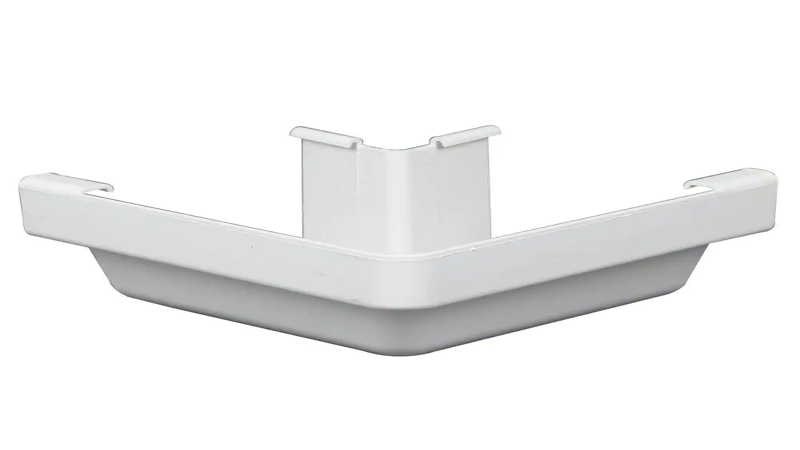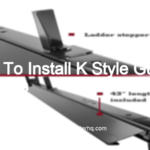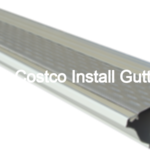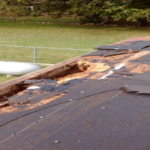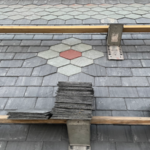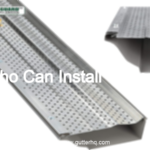If your home’s gutters are old and in need of replacement, or if they’ve been damaged in a storm, you’ll need to know how to re-install a gutter. It’s a relatively simple process, but there are a few things you need to know before you get started.
First, you’ll need to remove the old gutter. This is usually done by unscrewing it from the fascia board or the gutter hangers. Once the old gutter is removed, you can measure the length you need for the new gutter.
Next, you’ll need to cut the new gutter to size. It’s important to make sure the cuts are straight, so a gutter installation kit can be helpful. Once the new gutter is cut to size, you’ll need to install the gutter hangers. These hangers will hold the gutter in place.
Finally, you can install the new gutter. Start at one end and work your way to the other, attaching the gutter to the hangers as you go. Once the gutter is installed, you can add the downspouts. These can be either attached to the gutter or the fascia board.
How do you Rehang gutters?
If your gutters are sagging or pulling away from your home, it is time to rehang them. This is a relatively easy process, but it is important to do it correctly to ensure that your gutters will function properly and not cause any damage to your home.
To rehang your gutters, you will need to remove the old hangers and brackets. This can be done with a screwdriver or power drill. Once the old hardware is removed, you can then install the new hangers and brackets. Make sure that the new hardware is securely in place before attaching the gutters.
Once the gutters are rehung, you should check them to make sure that they are draining properly. If you see any water pooling in the gutters, you may need to adjust the angle of the gutters or add additional downspouts to help with drainage.
Can I replace gutters myself?
If you have experience working with tools and are comfortable working on a ladder, then you can replace your gutters yourself. However, if you have never replaced gutters before, it is best to hire a professional.
Can seamless gutters be removed and reinstalled?
Seamless gutters can be removed and reinstalled, but it is a more complicated and time-consuming process than simply taking down and reinstalling traditional gutters. Seamless gutters are made to fit the specific measurements of your home, so they will need to be cut to size when they are reinstalled. This means that you will need to hire a professional to do the job, which will likely cost more than simply replacing traditional gutters.
What should you not do when installing gutters?
- Don’t use the wrong type of gutter. Make sure you use gutters that are made of the same material as your home’s exterior.
- Don’t install gutters that are too small. Small gutters can’t handle heavy rains and will overflow, causing water damage to your home.
- Don’t forget to slope the gutters. Gutters should be installed with a slight slope so that water can drain properly.
- Don’t use nails to attach gutters. Use screws or hangers to ensure that the gutters are properly secured.
- Don’t forget to seal the gutters. Sealing the gutters will help prevent leaks and keep debris from clogging them.
Do you nail or screw gutters?
There is no one definitive answer to this question. While some people may opt to nail their gutters in place, others may choose to screw them in. Ultimately, it comes down to personal preference and what works best for the individual. There are pros and cons to both methods, so it’s important to weigh all the options before making a decision.
Nailing gutters in place can be a quick and easy process. All that is needed is a hammer and some nails. This method is typically less expensive than screwing gutters in, and it can be just as effective if done properly. However, there is a greater chance that gutters will come loose over time if they are only nailed in place. This can be a problem if gutters are not regularly checked and maintained.
Screwing gutters in place is more time-consuming than nailing, but it can provide a more secure hold. This is especially important in areas that experience high winds or severe weather conditions. In addition, screwing gutters in place can make them easier to remove and replace if needed. However, the initial investment for this method is typically higher than simply nailing gutters in place.
How do you tell if gutters are installed correctly?
- Look at the alignment of the gutters. They should be level and even with the edges of the roof.
- Check the fasteners to make sure they are all secure and the gutters are not loose.
- Inspect the gutters for any gaps or leaks. These can cause water to seep through and cause damage.
- Make sure the downspouts are installed correctly and are draining properly.
- Check for any debris or leaves that may be clogging the gutters. This can cause water to back up and damage the system.
Can you fix a sagging gutter?
A sagging gutter is usually caused by one of two things: either the gutter is full of debris and needs to be cleaned out, or the gutter hangers are loose and need to be tightened. To clean out a gutter, you will need a ladder, a bucket, and a pair of gloves. First, put on the gloves to protect your hands from the debris. Next, set the ladder up against the gutter and climb up so that you can reach into the gutter. Use the bucket to scoop out the debris and leaves, and then dispose of it. Once the gutter is clean, check the hangers to see if they are loose. If they are, use a screwdriver or a drill to tighten them.
Final Word
If your home’s gutters are in need of a repair or replacement, it’s important to know how to properly re-install them. This process can seem daunting, but with a little bit of know-how and the right tools, it’s actually quite simple.
Start by removing the old gutter system, being careful not to damage the fascia or soffit. Once the old system is out, measure the length of the new gutters and cut them to size. Attach the new gutters to the fascia using hangers or brackets, making sure they are level and secure.
Finally, install the downspouts and test the system to make sure it is draining properly. With a little bit of time and effort, you can easily re-install your home’s gutters and keep them functioning properly for years to come.
